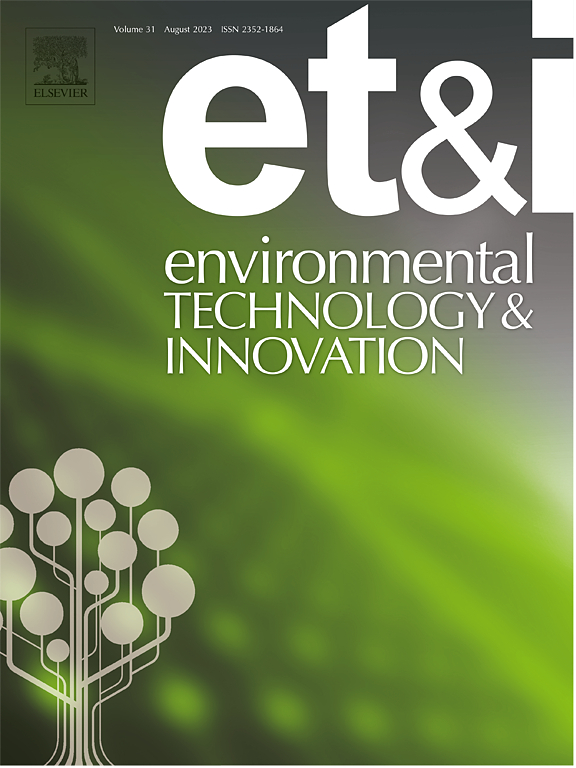Assessment of soil microbial communities and diversity in typical coastal wetlands along a succession gradient: Implications for reconstructing the long-term evolution of coastal wetlands
IF 6.7
2区 环境科学与生态学
Q1 BIOTECHNOLOGY & APPLIED MICROBIOLOGY
引用次数: 0
Abstract
To more precisely reconstruct the long-term evolutionary processes of coastal wetlands in the past using microbial deposition records, it is essential to differentiate various types of coastal wetlands along sea-land gradients based on their community and diversity characteristics, and to identify the primary factors influencing them. In this study, based on high-throughput sequencing technology, we revealed the microbial community composition and diversity characteristics of four major coastal wetlands in Bohai Bay, including Lagoon & Estuary (L&E), Suaeda (SU), Freshwater-Phragmites (F-P), and Freshwater-Weeds (F-W), and discussed their relationship with environmental factors. The results showed that dominant microbial communities had clear indicative significance for corresponding wetlands. In the L&E wetlands, the microbial communities are characterized by dominant taxa spanning multiple taxonomic ranks: Desulfobacterota, Gammaproteobacteria, and Desulfuromonadia. In SU wetlands, the indicator taxa comprised Flavobacteriales, Balneolales, and Planococcaceae. In F-P wetlands, the differentially abundant taxa included Acidobacteriota, Myxococcota, Gemmatimonadota, and Planctomycetota. Salinity and vegetation cover were the most important factors affecting soil microbial composition in Bohai Bay coastal wetlands. F-P wetlands had the highest richness and evenness of microbial species, followed by L&E, F-W, and SU wetlands. Na+ and Cr contents were negatively correlated with microbial diversity, while vegetation cover, TOC and P contents were positively correlated with microbial diversity. Our study emphasized the significance of understanding the relationship between microbial community composition and environmental factors in different wetlands in Bohai Bay, and lay a foundation for wetland biodiversity conservation and reconstruction of past ecosystem succession processes.
沿演替梯度的典型滨海湿地土壤微生物群落和多样性评价:重建滨海湿地长期演变的意义
为了利用微生物沉积记录更精确地重建过去滨海湿地的长期演化过程,必须根据滨海湿地的群落和多样性特征,沿海陆梯度区分不同类型的滨海湿地,并确定影响滨海湿地的主要因素。本研究基于高通量测序技术,揭示了渤海湾4个主要滨海湿地的微生物群落组成及多样性特征。河口(L&;E)、藻门(SU)、淡水芦苇(F-P)和淡水杂草(F-W),并讨论了它们与环境因子的关系。结果表明,优势微生物群落对相应湿地具有明确的指示意义。在L&;E湿地,微生物群落以优势类群为特征,跨越多个分类等级:Desulfobacterota、Gammaproteobacteria和Desulfuromonadia。SU湿地的指示类群为黄杆菌科、扁豆菌科和平球菌科。在F-P湿地,差异丰富的分类群包括酸杆菌门、黏菌门、双胞菌门和植菌门。盐度和植被覆盖是影响渤海湾滨海湿地土壤微生物组成的最重要因素。F-P湿地微生物物种丰富度和均匀度最高,其次为L&;E、F-W和SU湿地。Na+和Cr含量与微生物多样性呈负相关,植被覆盖度、TOC和P含量与微生物多样性呈正相关。本研究强调了了解渤海湾不同湿地微生物群落组成与环境因子关系的重要意义,为湿地生物多样性保护和重建过去的生态系统演替过程奠定了基础。
本文章由计算机程序翻译,如有差异,请以英文原文为准。
求助全文
约1分钟内获得全文
求助全文
来源期刊

Environmental Technology & Innovation
Environmental Science-General Environmental Science
CiteScore
14.00
自引率
4.20%
发文量
435
审稿时长
74 days
期刊介绍:
Environmental Technology & Innovation adopts a challenge-oriented approach to solutions by integrating natural sciences to promote a sustainable future. The journal aims to foster the creation and development of innovative products, technologies, and ideas that enhance the environment, with impacts across soil, air, water, and food in rural and urban areas.
As a platform for disseminating scientific evidence for environmental protection and sustainable development, the journal emphasizes fundamental science, methodologies, tools, techniques, and policy considerations. It emphasizes the importance of science and technology in environmental benefits, including smarter, cleaner technologies for environmental protection, more efficient resource processing methods, and the evidence supporting their effectiveness.
 求助内容:
求助内容: 应助结果提醒方式:
应助结果提醒方式:


